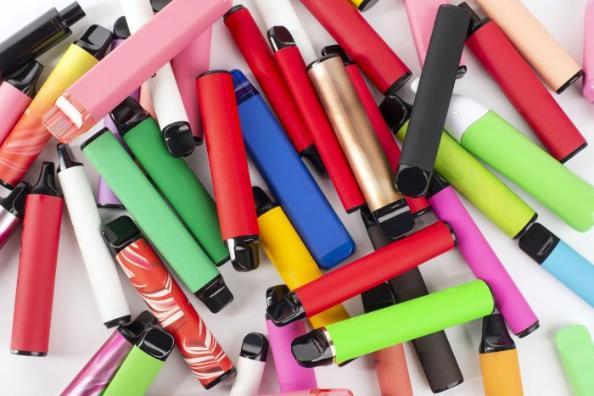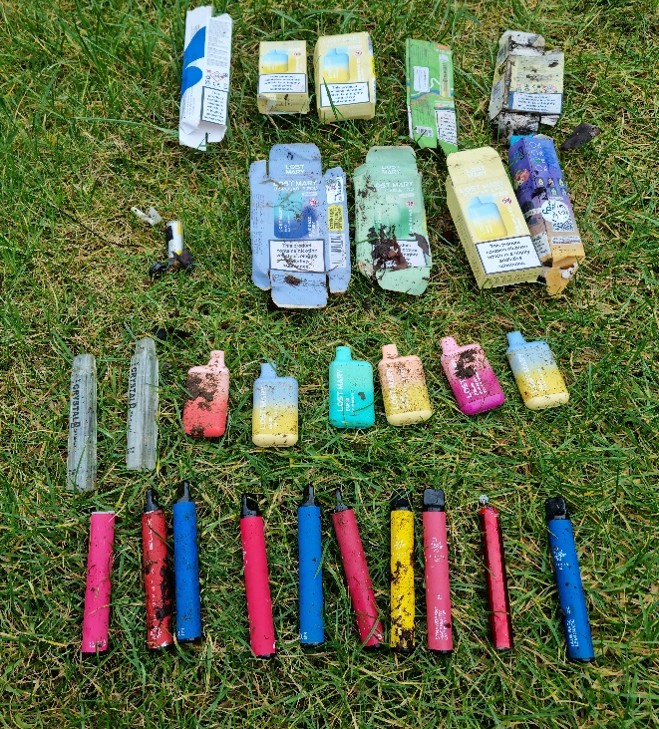Vaping: A throwaway habit?
Published: 29 March 2023
This blog takes a closer look at the fierce public health and environmental debates that have emerged around disposable e-cigarettes.
Published 29th March 2023
By Marissa Smith, Caroline Vaczy and Shona Hilton.
E-cigarettes (or vapes) have become more and more popular since their invention in 2003, particularly among young people. Although experts agree that they should primarily be used as a smoking cessation tool, many people who have never smoked are taking up vaping, exposing them to due to associated health and safety risks. A variety of models or ‘generations’ of e-cigarettes have become available, often with brand and marketing features that appeal to young people.
Disposable e-cigarettes (commonly referred to as disposable vapes) are pre-filled with e-liquids consisting of water, nicotine, flavourings and a propylene glycol or vegetable glycerin base, and are designed to be used until the liquid runs out and then thrown away, unlike refillable vapes. They retail for around £5 to £7 in the UK, as compared with the £15 to £30 cost of a refillable vape. In Great Britain, data captured in 2022 found that disposable e-cigarettes have become the most common device type among e-cigarette users (52.0% compared to 7.7.% in 2021), with Elf Bar and Geek Bar being the most popular brands.
This blog takes a closer look at the fierce public health and environmental debates that have emerged around disposable e-cigarettes. Working with young people on a Cancer Research UK-funded project, we answer four important questions about current debates on e-cigarettes.

Why are they popular/attractive among young people?
In our paper “Youths’ engagement and perceptions of disposable e-cigarettes: a UK focus group study,” recently published in BMJ Open, we examine young people’s perceptions of and engagement with disposable e-cigarettes, including awareness of product characteristics, appeal of products and flavours, perceptions of harm, and perceived target group. Our study highlights that disposable e-cigarettes are perceived by young people to be ‘cool’, ‘fashionable’, and enticing and are viewed as a modern lifestyle ‘accessory’. Disposable e-cigarette products are attractive to young people because of their vibrant colours and flavours, low cost, and ease of access.
Participants also mentioned the positives of the compact design of the product as this allowed them to be discretely carried and hidden when in school. We found that youths commonly mistake the products for other everyday products, such as highlighters and tins of mints. This combined with the compact design of the products raises concerns about the way manufacturers design the products and if this has been done intentionally to target a younger audience.
What happens to disposable vapes? A real-world experiment
The increased popularity of disposable e-cigarettes (from brands such as Puff Bar and Elf Bar), has resulted in the generation of more single-use plastic waste, as well as materials which are difficult to recycle such as batteries, a topic widely discussed by young people in our study, “Youths’ engagement and perceptions of disposable e-cigarettes: a UK focus group study.” Several participants raised concerns about the number of disposable e-cigarettes being discarded on the ground. Recently, Laura Young, a PhD student and climate activist, collected discarded disposable e-cigarettes littered in her hometown of Dundee. Based on concerns raised by youths in our study and the current public debate, we decided to explore our local areas to see how many disposable e-cigarettes we could find.
Caroline went on an hour-long walk in London and was struck by the number of disposable e-cigarettes she found. She came across twelve discarded e-cigarettes, averaging one every five minutes. Most of these were left in public gardens and green spaces. There was a noticeable concentration of discarded e-cigarettes around the university she passed as well as a marked absence of vapes after crossing the river into the Westminster area.
Marissa, who lives in Ayrshire, did a similar walk and she too was alarmed about the number of discarded disposable e-cigarettes. Over the course of the one-hour walk, Marissa reported seeing a total of 18 e-cigarettes, averaging one every three minutes. There was a notable number of disposable e-cigarettes found in the area surrounding the high school and local shops that sell these products. Here she shows her collection from the walk.

What are the environmental impacts of disposable vapes?
As disposable e-cigarettes contain valuable materials such as lithium batteries and copper, they are classed as Waste Electrical and Electronic Equipment (WEEE). If damaged when thrown away, lithium batteries can cause fires at waste disposal plants, so consumers should dispose of them at a local electronics recycling centre or at the shop where they bought the device. However, there appears to be confusion across the marketplace with respect to the WEEE regulations and how to comply. Material Focus, a non-profit organisation, are pushing for e-cigarette recycling to be made much easier, and for manufacturers and retailers to install collection points inside shops.
The environmental impact and recycling of disposable e-cigarettes is a ‘hot topic’ at the moment, particularly in Scotland. An urgent review has been commissioned by the Scottish government into the environmental impact of disposable vapes - which could lead to an outright ban. The move comes amid emerging concerns around the negative consequences of single-use vaping devices.
Concluding thoughts: would a blanket ban work?
Some observers of e-cigarette debates suggest that banning disposable e-cigarettes would be a step in the right direction, arguing that e-cigarettes would still be available in a rechargeable form, which, although not without their own environment impacts, is the eco-friendlier option. Others argue that this approach is hypocritical as cigarettes, which also pose an environmental threat, are still on the market.
Results from our study highlighted that policymakers could consider measures to discourage youth experimentation with disposable e-cigarettes, while not making the products inaccessible to vulnerable groups who may use them as a smoking cessation option. In addition, we suggest the growing need for policymakers to work together to develop and implement comprehensive policies to prevent initiation of e-cigarette use among young people and evaluate the safe recycling and disposal of disposable e-cigarettes.
For more information on how to recycle e-cigarettes visit https://www.recycleyourelectricals.org.uk/how-to-recycle-electronics/what-electronics-can-be-recycled/recycle-vapes/
First published: 29 March 2023

